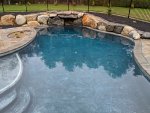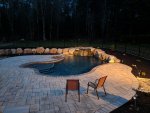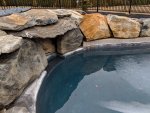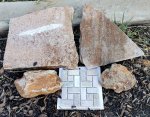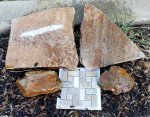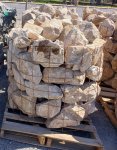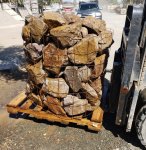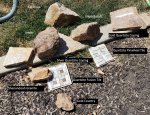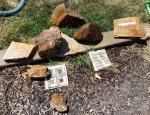We are in the rock shopping phase and it is nuts here.
Since the rains ended in late March all the builders have been buying up and using all the local inventory.
The place we thought would be our vendor only has moss rock left and we are trying to avoid using moss rock for the grotto/weeping wall features
We wanted a little more durability and different coloration options
I have names of boulders staff told me during prior visits but I'm having a hard time tracking down more information on them and nobody has them in stock nearby
-gold country
-great falls
-waterwash
-siskiyou gold
Today we found a place with plenty of CALISTOGA boulders in stock.
*Our PB went with us to the last few rock suppliers that were out of supplies but he was not with us today b/c it just happened to be on the way an errand we were running
I put our tile and our coping sample near it and we think it might work.
I forgot the bottle of water and sponge to wet test it though
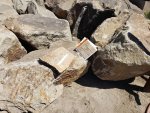
I tried asking the nearest staff member for more detail about calistoga boulders but they had no clue.
Can anyone tell me what kind of rock that is (sedimentary family....granite etc.)?
Higher density and better durability than moss rock?
Good for water feature application in salt water pool like we need?
I know the warning is avoid rock that flakes etc.
Any advice is appreciated
Since the rains ended in late March all the builders have been buying up and using all the local inventory.
The place we thought would be our vendor only has moss rock left and we are trying to avoid using moss rock for the grotto/weeping wall features
We wanted a little more durability and different coloration options
I have names of boulders staff told me during prior visits but I'm having a hard time tracking down more information on them and nobody has them in stock nearby
-gold country
-great falls
-waterwash
-siskiyou gold
Today we found a place with plenty of CALISTOGA boulders in stock.
*Our PB went with us to the last few rock suppliers that were out of supplies but he was not with us today b/c it just happened to be on the way an errand we were running
I put our tile and our coping sample near it and we think it might work.
I forgot the bottle of water and sponge to wet test it though

I tried asking the nearest staff member for more detail about calistoga boulders but they had no clue.
Can anyone tell me what kind of rock that is (sedimentary family....granite etc.)?
Higher density and better durability than moss rock?
Good for water feature application in salt water pool like we need?
I know the warning is avoid rock that flakes etc.
Any advice is appreciated


